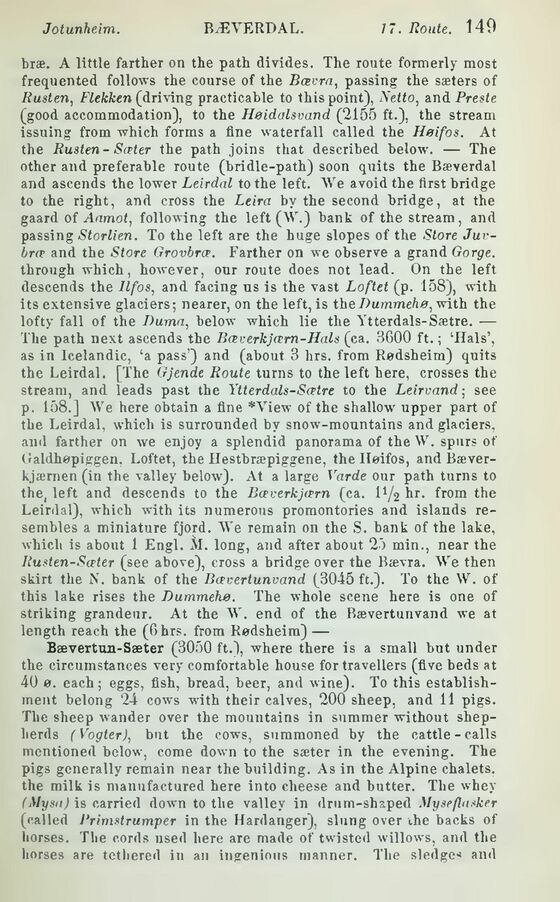
Full resolution (JPEG) - On this page / på denna sida - Norway - Pages ...

<< prev. page << föreg. sida << >> nästa sida >> next page >>
Below is the raw OCR text
from the above scanned image.
Do you see an error? Proofread the page now!
Här nedan syns maskintolkade texten från faksimilbilden ovan.
Ser du något fel? Korrekturläs sidan nu!
This page has never been proofread. / Denna sida har aldrig korrekturlästs.
bræ. A little farther on the path divides. The route formerly most
frequented follows the course of the Bævra, passing the sæters of
Rusten, Flekken (driving practicable to this point), Netto, and Preste
(good accommodation), to the Heidalsvand (2155 ft.), the stream
issuing from which forms a fine waterfall called the Heifos. At
the Rusten-Sæter the path joins that described below. — The
other and preferable route (bridle-path) soon quits the Bæverdal
and ascends the lower Leirdal to the left. We avoid the first bridge
to the right, and cross the Leira by the second bridge, at the
gaard of Aamot, following the left (W.) bank of the stream, and
passing Storlien. To the left are the huge slopes of the Store
Juv-bræ and the Store Grovbræ. Farther on we observe a grand Gorge.
through which, however, onr route does not lead. On the left
descends the Ilfos, and facing us is the vast Loftet (p. 158), with
its extensive glaciers; nearer, on the left, is theDummehe, with the
lofty fall of the Duma, below which lie the Ytterdals-Sætre. —
The path next ascends the Bæverkjæm-Hals (ca. 8600 ft.; ‘Hals’,
as in Icelandic, ‘a pass’) and (about 3 hrs. from Rødsheim) quits
the Leirdal. [The Gjende Route turns to the left here, crosses the
stream, and leads past the Ytterdals-Sætre to the Leirvand; see
p. 158.] We here obtain a fine *View of the shallow upper part of
the Leirdal, which is surrounded by snow-mountains and glaciers,
and farther on we enjoy a splendid panorama of the W. spurs of
Galdhøpiggen, Loftet, the Hestbræpiggene, the Iløifos, and
Bæver-kjærnen (in the valley below). At a large Varde our path turns to
the, left and descends to the Bæverkjærn (ca. D/2 hr. from the
Leirdal), which with its numerous promontories and islands
resembles a miniature fjord. We remain on the S. bank of the lake,
which is about 1 Engl. M. long, and after about 25 min., near the
Rusten-Sæter (see above), cross a bridge over the Bævra. We then
skirt the N. bank of the Bævertunvand (3045 ft.). To the W. of
this lake rises the Dummehe. The whole scene here is one of
striking grandeur. At the W. end of the Bævertunvand we at
length reach the (6 hrs. from Rødsheim) —
Bævertun-Sæter (3050 ft.j, where there is a small but under
the circumstances very comfortable house for travellers (five beds at
40 0. each; eggs, fish, bread, beer, and wine). To this
establishment belong 24 cows with their calves, 200 sheep, and 11 pigs.
The sheep wander over the mountains in summer without
shepherds (Vogter), but the cows, summoned by the cattle - calls
mentioned below, come down to the sæter in the evening. The
pigs generally remain near the building. As in the Alpine chalets,
the milk is manufactured here into cheese and butter. The whey
(Mysa) is carried down to the valley in drum-shaped Myseflasker
(called J’rimstrumper in the Hardanger), slung over ihe backs of
horses. The cords used here are made of twisted willows, and the
horses are tethered in an ingenious manner. The sledge* and
<< prev. page << föreg. sida << >> nästa sida >> next page >>